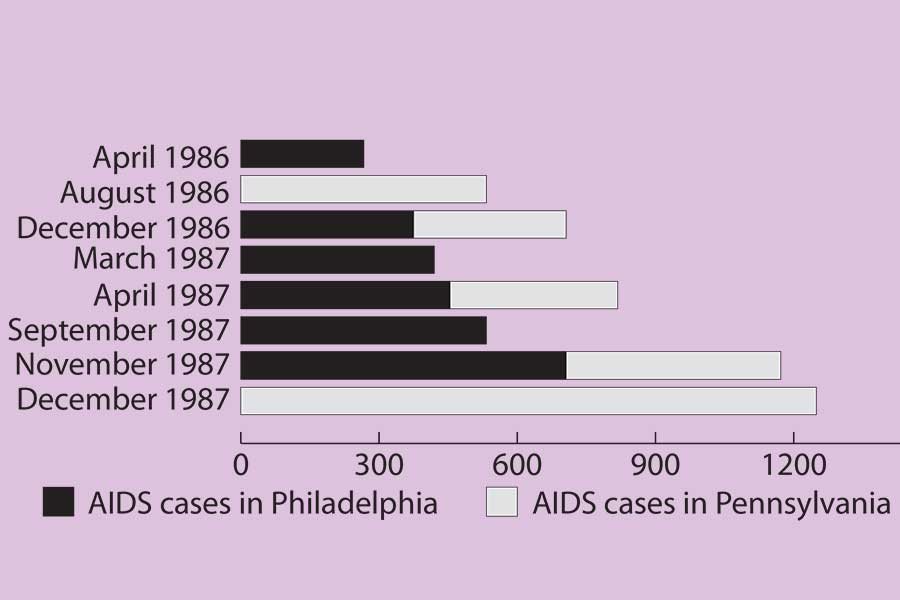• On June 5, 1981, the Centers for Disease Control issues a warning about pneumocystis carinii, a rare form of pneumonia, after five gay men in Los Angeles contract the disease.
• PGN’s first story regarding HIV/AIDS runs in the July 10-23, 1981, issue under the headline “The latest gay disease: Cancer.”
• In the fall of 1981, the newly formed Philadelphia Physicians for Human Rights meets with the Philadelphia Health Department about the growing disease impacting gay men.
• In 1982, Dr. John Hanrahan of the Centers for Disease Control’s Task Force on Kaposi’s Sarcoma and Opportunistic Infections travels to Philadelphia to interview two men for a study on the new “gay cancer.”
• The term Acquired Immune Deficiency Syndrome is used publicly for the first time on July 27, 1982, during a community meeting in Washington, D.C.
• New Jersey Gov. Thomas Kean issues a proclamation Jan. 3, 1983, declaring February AIDS Awareness Month, the first such proclamation issued in the nation.
• In 1983, the Food and Drug Administration issues a blanket ban on blood donation by men who have had sex with men.
• Philadelphia appoints its first Coordinator for Issues Relating to AIDS, Muriel Bell, in the spring of 1983.
• Philadelphia hosts its first large-scale AIDS symposium at the Adams Mark Hotel in June 1983. About 300 people participate.
• The AIDS Task Force of Philadelphia is formed in 1983.
• In a September 1983 proclamation, Philadelphia Mayor Bill Green recognizes the city’s first AIDS Awareness Month.
• The first International AIDS Conference is held in Atlanta in April 1985.
• On March 24, 1986, Mayor W. Wilson Goode issues a ban on AIDS discrimination throughout Philadelphia government.
• On June 11, 1986, the Centers for Disease Control reports 21,521 cases of AIDS nationwide, with 11,713 deaths.
• On April 1, 1987, President Ronald Reagan delivers a speech at the College of Physicians in Philadelphia in which he calls AIDS “public-health enemy number-one” and urges youth to remain abstinent.
• ACT Up Philadelphia holds its first demonstration Sept. 13, 1987, outside the Liberty Bell to call for increased local funding for AIDS.
• The Pennsylvania Department of Health establishes an AIDS Unit in September 1988.
• David Acosta and other local activists start Our Living Legacy in 1988 at Painted Bride Art Festival to showcase AIDS-related work.
• Philadelphia hosts a portion of the NAMES Project AIDS Memorial Quilt from May 11-14, 1989, at the Philadelphia Armory. More than 7,000 came to see the quilt.
• Eighteen-year-old Ryan White dies of AIDS in Indiana on April 8, 1990. Congress went on to pass legislation in his name that continues to fund the largest amount of HIV/AIDS services in the nation.
• About 75 members of ACT UP Philly interrupt Pennsylvania Gov. Bob Casey’s inauguration on Jan. 15, 1991, to call for enhanced attention to AIDS issues.
• On July 27, 1992, Philadelphia Mayor Ed Rendell formally authorizes a needle-exchange program that had been operating underground.
• The groundbreaking HIV/AIDS film “Philadelphia” is released Dec. 22, 1993.
• The World Health Organization reports the millionth case of AIDS worldwide Dec. 31, 1994.
• In June 1995, the FDA approves the first protease inhibitor for antiretroviral treatment.
• In December 1995, the Rite Aid corporation agrees not to release HIV-prescription information to patient employers in Pennsylvania after a local lawsuit.
• The largest-ever clinical trial for a therapeutic AIDS vaccine begins March 18, 1996, at Graduate Hospital in Philadelphia.
• UNAIDS reports 30-million people worldwide living with HIV/AIDS in 1997.
• The United Nations General Assembly creates the Global Fund in June 2001 to combat the spread of HIV throughout the globe.
• In November 2002, the FDA approves the first rapid HIV test.
• President George w. Bush creates the President’s Emergency Plan for AIDS Relief in January 2003 to support AIDS-relief efforts worldwide.
• A 2008 national study finds Philadelphians are being infected with HIV at a rate five times the national average.
• After 22 years, the ban on HIV-positive individuals entering the United States is lifted in January 2010.
• A September 2010 report from the CDC finds that about 70 percent of men who have sex with men in Philadelphia are unaware of their HIV status.
• The FDA approves pre-exposure prophylaxis in July 2012 as a new means of HIV prevention. n

